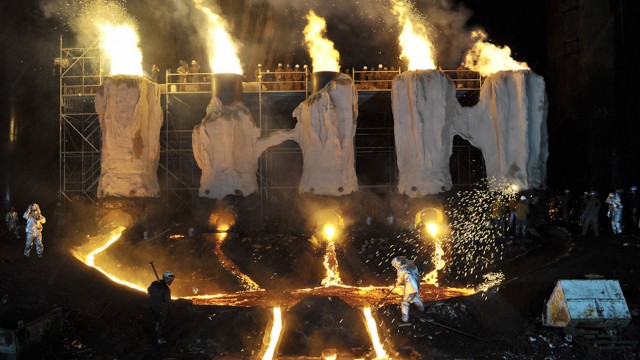Matthew Barney isn’t a filmmaker, and River of Fundament isn’t a film. Matthew Barney is an artist, and River of Fundament is an abstraction in the film format. Over the course of almost 6 hours in 3 separate acts, Matthew Barney combines live performance art installations, opera, drama, and sculpture to examine death, mourning, and reincarnation as filtered through Egyptian and Native American mythology and the American auto industry. Symbolism begets ritual begets symbolism, repetition and abstraction flow from narrative through music, and deep meaning flitters at the edge of realization; through many forms, Barney connects the meaning of life through death, sex and shit.
In one form, River of Fundament serves as a eulogy for Norman Mailer; in another, it serves as an adaptation of Mailer’s 1983 novel Ancient Evenings. Norman Mailer is dead, but everybody reincarnates through somebody else. To transform to the next level of being, one must travel a river of shit and emerge on the other side using the soul of an animal. Here, Norman exists in three states; young and white (Norman’s real life son John Buffalo Mailer), older and black (Milford Graves), and oldest and Native American (Dave Bald Eagle), transforming through a dead cow in the basement of his house flooded by a river of shit that gives life to dead souls. Norman is followed by his bifurcated Ka: Isis (Aimee Mullins) and Osiris (Matthew Barney), two Egyptian siblings who embrace life in all its foibles, including sex, pain and blood.
Norman and his Ka attend their own wake, a gathering in Norman’s home where Egyptian Pharaohs hobnob with New York City’s art elite while they tribute Mailer’s presence through readings and song. Hathfertiti, Set, and Horus mingle with the likes of Elaine Stritch, James Toback, and Fran Leibowitz, as Jonathon Bepler’s deeply ritualistic score plays through the evening. We are born between piss and shit; thus, golden piss, shit, and decay play important roles throughout the proceedings. While everybody else is mourning, the Egyptians are having their own psychosexual relationship drama of incest and perversion relating to their own death, rebirth, and reincarnation.
Each act of River of Fundament is tied to a separate operatic art happening dealing with an aspect of the auto industry. A 1967 Chrysler Crown Imperial is destroyed and reincarnated as a 1979 Pontiac Trans Am, born of a culture tied to the compact fuel efficiency of the 1970s fuel shortages. First, they’re killed by the dealers of America, then they’re killed by the auto industry, and finally by the chop shops. All is decay and destruction only to be rebirthed through screams, sex, and rituals.
Released in a cycle of 3 full movies with intermissions, intended to be witnessed in a single outing, at almost 6 hours, Barney’s immersive experiment is a butt-busting experience of hubris. Just for some relativity, Wagner’s Gotterdammerung only runs 4:30. By sheer length alone, River of Fundament is an endurance run that tests patience, continuing long after ir has worn out its welcome. But, then, Ancient Evenings was a 700+ page endurance novel, and life can be an endurance test of its own. Seeing it in one day, as Barney intends, is a feat into itself, though it rewards the experience by reinforcing the repetitious motifs even as it sacrifices the attention needed for the finale.
To keep people’s attention, Barney constantly ups the game. Act III is an orgy of destruction and reconstructions, sex and fighting, blood and shit. By the time a woman inserts a third eye into another woman’s anus, the movie is already in a state of full on grotesquerie that feels forced if not entirely unwelcome. Up to that point, Barney’s darkly baroque imagery contrasting with the grit of city living, creates for some vital imagery that one isn’t soon to forget. After that, it seems like Barney is rubbing your face in all of it for actually finishing the piece.
To watch River of Fundament is to wrestle with Barney’s abstract obsessions, even if they aren’t entirely coherent. Is there a point to be made about modern echoes of ancient rituals through industrial lenses having to do with life love and all of our basest experiences? Is this just intellectual wankery? Could it be uncharitably described as Transformers for intellectuals? Whatever it is, it’s visually stunning and more than a bit entertaining; it just doesn’t seem as serious as the length suggests. Or is it?

